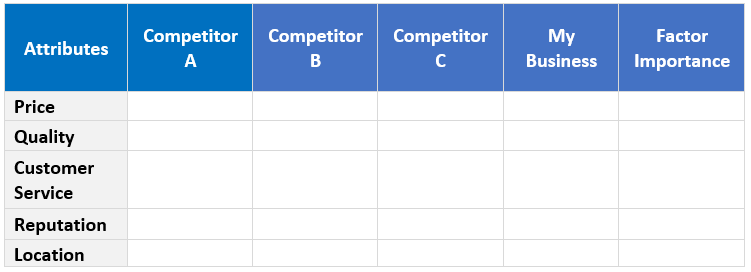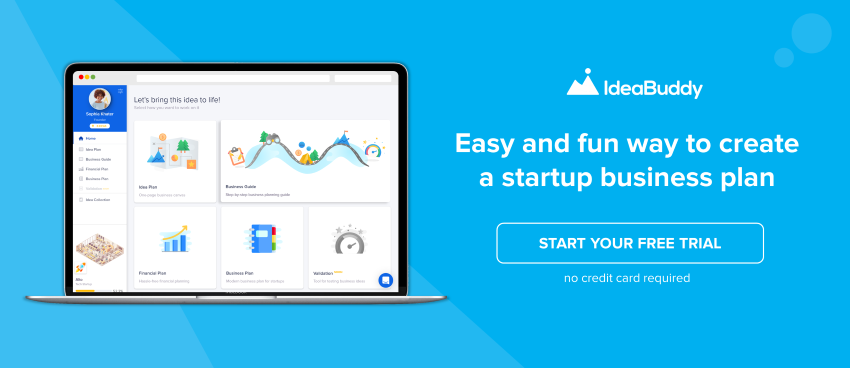One of the most important things to do when starting a business is to get a better understanding of your competitors. The easiest way to do this is by using a template or a tool for competitor analysis.
This is a stage when entrepreneurs focus on their own business idea without looking at what else is happening in the market.
The next question is: How do you conduct a competitor analysis? More specifically, how do you do it in a way that is meaningful, and that provides useful insight to help make your new business successful?
Let’s look at all these questions in more detail, starting with why you should conduct a competitor analysis.
Every business has competitors
Even if you have an absolutely unique idea or product that nobody else has thought of, you still have competitors. They might be indirect competitors, but they are still competitors.
Why? Any business or brand that can attract customers that could otherwise do business with you is a competitor.
An example of Airbnb
Take Airbnb as an example. It is known as a market disruptor as it presented travelers with a new and unique alternative for booking travel accommodation. When Airbnb launched, it had no significant direct competitors doing the same things it was – how could there be when AirBnB was the industry disrupter?

However, hotels, motels, hostels, campsites, etc were still in competition with Airbnb, albeit indirectly. The same applies to booking aggregators and comparison tools like Booking.com.
All these types of businesses are not direct AirBnB competitors as they don’t do exactly the same thing, but they are indirect competitors as they do attract customers that AirBnB also targets.
Why you need to do a competitor analysis?
There are several compelling reasons to analyze your competitors. High up on this list of reasons is to understand how your business stands out in the market. A competitor analysis will also help show how your business will attract customers who may already be clients or customers of the businesses you will soon be in competition with.
Furthermore, the modern world of business is very fast-paced. Trends change quickly, launching a new business is easier than it used to be, communications are instantaneous, and the marketing platforms available today make it possible to reach very large audiences quickly and often affordably.
So, the more you know about your business and how it stands in the market, the better.
Conducting a competitor analysis can also give you a competitive advantage by helping you develop strategies that will win business from your competition. For example, by doing a competitor analysis, you can identify areas where a competitor is stronger than you, so you can take steps to improve your business.
You can also exploit the areas where you are stronger.
Finally, conducting a competitor analysis will help you understand your customers better.
Categorizing your competitors
Now let’s get into the nitty-gritty of doing the competitor analysis. You first need to identify your competitors, and then you should categorize them as direct or indirect:
- Direct competition: businesses selling products or services that are the same or are very similar to yours
- Indirect competition: businesses selling products or services that are different from yours but might satisfy the same customer need
Generally, direct competitors are more important, but that doesn’t mean you should ignore indirect competitors, as they can also take market share that you hope to capture.
What you should compare
The objective of a competitor analysis is to understand your competition’s strengths and weaknesses in relation to your business.
The best way to do this is to breakdown your analysis into attributes. Here’s an example of a breakdown of five specific attributes you can analyze:
- Price – does the competitor have higher or lower prices than yours, and compared to others in the market? Does their pricing structure make their products more attractive to customers, i.e., have they got their pricing right? Or, have they overpriced their products to the point that they are unattractive to customers?
- Quality – what is the perceived value and variety of the products and/or services offered by your competitors? Is this perceived value a benefit to the business or not?
- Customer service – how do your competitors treat their customers, and what levels of customer satisfaction do they achieve?
- Reputation – what level of credibility among various target segments do your competitors have? How loyal are their customers? How strong is their brand, and is it viewed favorably, indifferently, or negatively?
- Location – do your competitors have a good location? Does their location give them a competitive advantage? Does it make their business accessible to customers?
The above is just an example, as some of the attributes might not be as important to your business as something else. For instance, if you are a tech or engineering company, you might remove “location” from your analysis, replacing it with “talent acquisition and retention”, i.e. the availability, acquisition, and retention of talent.
Using a template for competitor analysis
The next step in the process is to use a structured approach to analyze your market rivals. The easiest way to do that is by using the template for analyzing your competitors. The objective here is to get information you can actually use to benefit your business.
Comparison Matrix
A comparison matrix is an ideal template for competitor analysis to provide you with the information you are looking for. It will give you an overview of the threat each competitor poses to your business and will highlight where your strengths lie.
Here’s a free template for competitor analysis you can use. It includes the comparison factors mentioned above:

The steps to using this Comparison Matrix competitor analysis template include:
- Add at least three competitors. They can be direct or indirect competitors.
- Assess your business and your competitors, scoring each of the attributes with a score: 1 for Poor; 2 for Fair; 3 for Good; and 4 for Excellent.
- Add a weighting to each attribute to signify its importance to your business. For example, Location is important to a manufacturing business in terms of rent costs and access to transport links, but the location is likely to be much more important to a retail store that needs footfall, i.e. people to walk through the door.
- The weight you give an attribute should be in comparison to the other factors in the table. It should be a percentage too, with the sum of each weighting equalling 100 percent.
Factor Importance
To explain the last point above further, here are examples from the two sectors mentioned previously – manufacturing and retail. Adding up the percentages in each example gives 100%.
A manufacturing business might give Factor Importance ratings as follows:
- Price – 25%
- Quality – 25%
- Customer Service – 20%
- Reputation – 20%
- Location – 10%
However, the Factor Importance ratings for a retail business might look something like this:
- Price – 25%
- Quality – 15%
- Customer Service – 20%
- Reputation – 15%
- Location – 25%
In other words, location is much more important for the retailer than the manufacturer.
Overall Score
Finally, calculate the overall score for you and your competitors by multiplying the score you give each attribute with that attribute’s Factor Importance percentage. Add all these figures together to get a final score. The business with the highest score will be the one with the most competitive offering in the market.
Let’s look at an example of competitor analysis, using the Factor Importance ratings of the manufacturing business above:

Table 2
We now multiply all the scores with the Factor Importance percentages. So, Competitor A gets a score of 4 for Price. Price has a Factor Importance of 25%, giving us a figure of 1. We do this for all the scores:

Table 3
You now add up all the scores for each business. The higher the score, the more competitive the business is in the market. Here are the results for this example:
- Competitor A – 3.4
- Competitor B – 3.3
- Competitor C – 3.05
- My Business – 3.1
So, in this example, you can see that Competitor A is the strongest in the market. This business owner is a new entrant so it doesn’t have a reputation in the industry at the moment. However, building that reputation through delivering on things like price, quality, and customer service will increase its score for the Reputation attribute, potentially putting it ahead of its strongest competitor.
Analyze your competitors with IdeaBuddy
The process above takes a bit of time and a bit of working out, but there is an even faster and easier method for doing a competitor analysis than a template – using the IdeaBuddy app.

IdeaBuddy is super-easy to use and has a clean, intuitive layout. Plus, it automates many of the above steps. You just enter your assessment of each attribute, and IdeaBuddy will give you the information you need to properly analyze your competition, including the Threat Level assessment of each competitor.
How do You Decide on the Rankings?
Okay, you have three competitors entered into your Comparison Matrix or to IdeaBuddy, but how do you now analyze each factor to allocate it a ranking?
This requires knowledge of the competitor which means you will need to do some research.
Ideally, you should try the customer experience first-hand, i.e. buy a product, visit the location, use a service, etc. This may not be possible in all situations, but where it is possible, trying the customer experience first-hand will be one of your best sources of information.
You should also analyze the company’s website:
- Browse their list of products/services
- Check their brochure and any other marketing materials they produce
- View their social media channels
- Look at, watch, or listen to their ads
- Check out reviews left for the company on review websites
- Read company reports
- Read blogs written by the company and by key individuals in the company
Finally, where possible, speak to people with first-hand knowledge of the competitors you are analyzing. This includes previous employees, current and former customers, and anyone else you know who has knowledge of the company.
Conducting a Competitor Analysis is Worth the Investment of Your Time
The insights you get from conducting a competitor analysis will give you invaluable information. Therefore, it’s worth the investment of your time. Of course, you should take advantage of tools that make the process more efficient and effective, such as the Free Comparison Matrix template offered here.
You should also try IdeaBuddy for free.
Also, don’t do this as a once-off exercise. After all, markets change, and your competitors can change too, not least to react to the launch of your business. So, go back to your competitor analysis periodically to update the information and gain new insights.
Read also: How To Do a SWOT Analysis For Your Business





